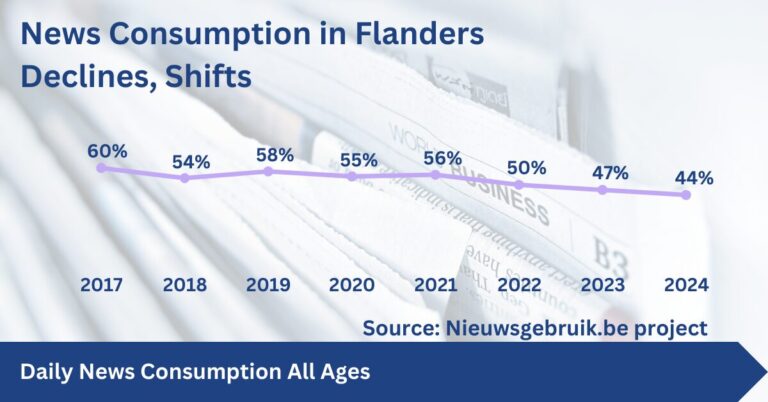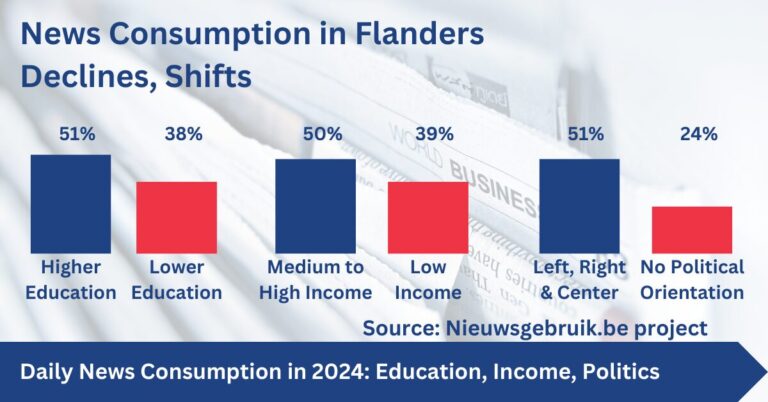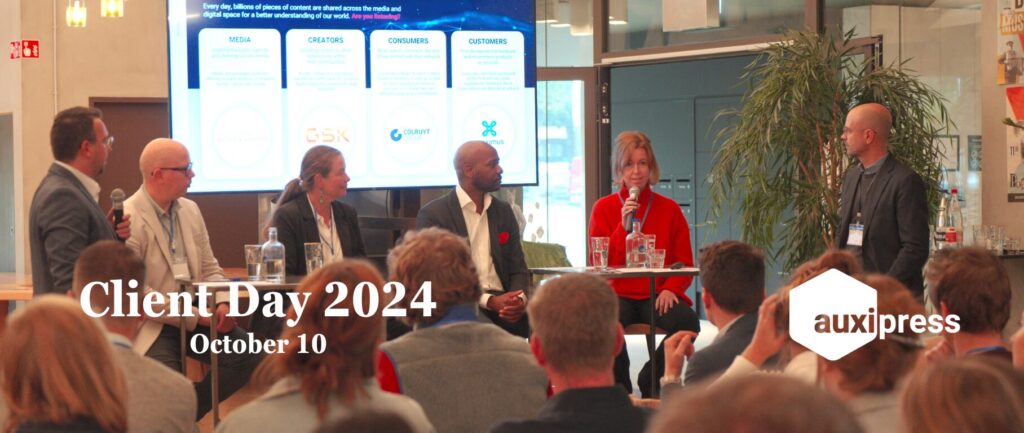News Consumption in Flanders is Declining, Shifting
5 Key Insights for Brands, NGOs, and Government Institutions
The media landscape is constantly evolving, as is the way people in Flanders consume news. This has direct implications for how organizations approach media monitoring and analysis. Recent data from Nieuwsgebruik.be reveals that Flemish people have been consuming news less frequently in recent years, with notable differences across age, education level, income, and political orientation. Brands, NGOs, and government institutions can extract valuable insights from these trends to optimize their PR, marketing, and media strategies. Here are five trends that organizations should consider.
1. Prioritize Relevance
Flemish people are checking the news less frequently. In 2017, 60% of people consulted the news several times a day; by 2024, this figure has dropped to just 44%. Consumers are increasingly selective about what they read. For brands and organizations, this means that they must make their messages even more relevant to stand out. Content that directly addresses the interests and concerns of the audience is more likely to capture attention.

2. Leverage Social Media Effectively
Young people aged 18 to 24 are increasingly disengaging from daily news consumption, with the percentage dropping from 44% in 2017 to just 29% in 2024. This demographic is turning away from traditional news sources and seeking information more often on social media. As a result, brands and NGOs can no longer afford to ignore a strong social media strategy, where short, visually engaging content takes precedence. Without this, it will be challenging to reach and engage young people. Brands should remember that, as news is now found on social networks, they should monitor social media too, to capture the impact of news on younger audiences.

3. Tailor Your Message to Education Levels
People with higher education levels are more likely to consult the news than those with lower education levels. In 2024, 51% of highly educated people check the news multiple times a day, compared to 38% of those with lower education levels. This calls for differentiated communication. Organizations should tailor their messages to the interests and needs of different education levels, offering in-depth content for the highly educated and more accessible content for a broader audience.
4. Customize for Income Groups
Income also plays a role in how often people consult the news. People with higher incomes check the news significantly more frequently than those with lower incomes. This requires attention to the accessibility of information. Government institutions and NGOs must ensure that their communication also reaches audiences who may consume news less frequently, for example, by offering information through multiple channels and in plain language.
5. No Political Preference = Low Interest in News
News consumption also varies significantly by political orientation. While people with left, center, or right-wing views regularly follow the news, there is a sharp decline in consumption among those who do not have a clear political preference. In other words, not all groups are equally well reached with standard news content. For brands and governments, this means that it is essential to carefully align their content and channel choices with the audience they want to reach, with varying tones of voice and thematic focuses.

Conclusion: Understanding Media Consumption is Key to Successful Communication
The trends in news consumption in Flanders offer valuable lessons on how brands, NGOs, and governments should adapt their communication strategies. By carefully segmenting their audiences, offering relevant content, and choosing the right media channels, organizations can enhance their impact and better respond to the needs and expectations of their audiences. Modern Media Intelligence and in-depth news and media analysis have become indispensable for keeping a finger on the pulse and anticipating new trends in a timely manner.
For those who want to communicate effectively in a rapidly changing media environment, Auxipress offers the expertise and tools to turn insights into action. Embrace Media Intelligence to stay relevant and always one step ahead. If you would like to explore these trends and ways to address them, feel free to contact our experts.
Source: The data in this article is sourced from the Nieuwsgebruik.be project, part of the Digital News Report from the Reuters Institute for the Study of Journalism, supported by Mediapunt, the Media Research Knowledge Center of the Flemish government. Wie raadpleegt nieuws in Vlaanderen? – nieuwsgebruik.be











